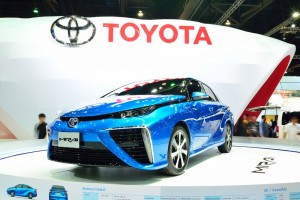Toyota to Dealers: Don't Sell Cars!
Yes, this is the last thing you would expect the world’s largest car maker to say, but it’s true. And it’s nothing to do with the Takata airbag scandal either. No, the problems for the Mirai are more fundamental.
Toyota has been advocating fuel cell powered cars more than any other car manufacturer. They have one, the Toyota Mirai. It’s an electric-powered vehicle whose primary source of power is not a battery.
Instead of a battery, it has a fuel cell that converts liquid hydrogen into electricity, which then turns an electric motor. There are times when the driver may demand more power than this fuel cell can provide. For those moments, a tiny 1kWh battery lends a helping hand to meet the demand.
In return, the vehicle has zero emissions, other than water vapor and perhaps a bit of heat. How’s that for government regulations and the public relations?
Despite Toyota investing billions of dollars into this new technology, they will only release about 300 of these vehicles between the Europe and the United States this year in 2016. Compare that number to the 10 million vehicles that the automaker sells per year, and you barely have a dot on the landscape.
That doesn’t stop Toyota from believing that hydrogen power is the way of the future. In fact, with the lobbying efforts of the Japanese government, the company appears to be betting its entire future on the technology.
It seems odd then that the company would be instructing dealers not to deliver the Mirai to customers. For a company whose slogan is, “Let’s Go Places,” the Marai sedan can’t really go anywhere.
This holds true even for the dealership that moves the most; a Toyota dealer in Santa Monica, California.
Why would Toyota do this? Honestly, they have solid reasoning.
Right now, there are 72 Toyota Mirai on the road in the US. However, these cars can’t just go to your conventional gas station to ‘fill ‘er up.” There aren’t enough refueling stations to keep the cars that are out there on the road, let alone enough fueling stations to support more cars being delivered.
Furthermore, what few stations that are out there don’t work very well. In fact, the move might be to keep Toyota and its dealers legally safe.
They are adamant to point out that they are still selling the car. What they’re not doing is delivering on the cars until more filling stations open up for the car.
Some people are quick to point out that Toyota should be building their own stations, and not rely on the taxpayer’s money to do it. They are saying that the world simply isn’t ready for hydrogen power quite yet. Perhaps in 50 years, but not now.



